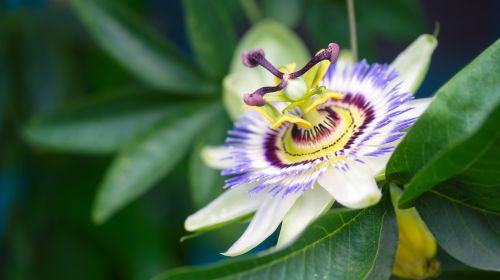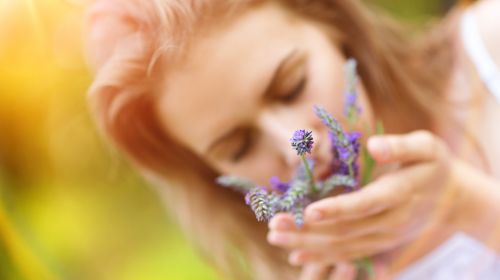Real lavender (Lavandula angustifolia) has been used for centuries against sleep disorders, nervous indigestion, anxiety and restlessness. Everything about the effect and application of the medicinal plant of 2020.
- Whether as tea, oil or bath additive: Lavender contributes to inner peace and relaxation.
- © iStock.com/ChamilleWhite
The real lavender native to the Mediterranean is known for its intense fragrance. Its name comes from the Latin word "lavare" (wash) and refers to its early widespread use as a bath additive. But the plant can do more: the essential oils contained in its flowers act in tea, oil or bath water to help you fall asleep, restlessness and stomach problems. It is therefore popularly known as "nerve herb".
Overview of article content
What is lavender?
Lavender belongs to the labiate family. There are over 30 different types of lavender, one of which stands out for the very characteristic ingredients in the essential oil: the real lavender (Lavandula angustifolia). This evergreen, perennial subshrub grows to a height of 30 to 70 centimeters and was originally found mainly in the Mediterranean – today the medicinal plant is cultivated worldwide.
Its purple and strongly fragrant flowers unfold their splendor between May and September. Medicinally used are the flowers harvested just before blooming, including the calyx and the essential oil obtained from them. The substances contained therein, linalool and linalyl acetate, as well as the tannins contained in the flowers, have a positive effect on sleep and psyche.
Because of its intense fragrance, lavender has been used in perfumes since the 17th century. The smell keeps moths away in the closet, in the garden it is supposed to drive away the aphids on neighboring plants. As an approved drug, it is used against anxiety, restlessness and exhaustion.
What does lavender work against?
Lavender has an antibacterial, anti-inflammatory, antispasmodic, calming and flatulence-inducing effect. That is why it is used particularly in the following situations:
Stress and exhaustion
sleep disorders
inner unrest
mild anxiety
depressive moods
functional upper abdominal discomfort (such as functional dyspepsia, Roemheld syndrome, meteorism, irritable bowel syndrome, flatulence)
functional circulatory disorders
How is lavender used and dosed?
Lavender can be used both externally and internally. For external use, 10 to 100 grams of dried lavender flowers or 1 to 3 grams of lavender oil are placed in a full bath. The bath itself should take 10 to a maximum of 20 minutes.
The inner application is done with 1 to 4 drops of lavender oil, which are taken on a piece of sugar or in water. For a lavender tea, 1 to 2 grams of lavender flowers are poured with 150 milliliters of hot (not boiling!) Water and stripped after 5 to 10 minutes of brewing. Both the oil and the tea can be used several times a day by adolescents and adults.
Can Lavender Have Side Effects?
Essential oils should never be used on babies and never around the eyes – just like asthmatics, there is a risk of narrowing of the airways. There are still too few studies available for the use of lavender in children under the age of 12, as well as in pregnancy and lactation, so use is not recommended here.
In some cases, an allergic reaction to lavender can occur. Before using lavender oil, the arm arch test is recommended, in which a drop of the essential oil is rubbed into the arm arch. If itching and reddening of the skin occur in the hours thereafter, there is a high probability of an allergy. Since essential oils can irritate the skin and mucous membrane, they should only be used diluted.
Anyone suffering from open wounds, skin diseases, fever, circulatory problems or heart failure should refrain from taking full baths. Applied internally (for example in the form of oil, capsules or tablets), lavender can temporarily cause belching, nausea and flatulence.
In principle, the use of lavender as a tea, oil or bath additive should always be discussed with a doctor or pharmacist in advance.
Where to buy lavender?
The medicinal plant can be purchased in drugstores, pharmacies and online shops in the form of tea, oil, tincture, capsules or bath additives. In addition, the essential oil is found as an additive in perfumes, soaps, fragrance oils, skin care products, herbal pillows and in cleaning agents or detergents. Lavender is also contained in numerous creams, lotions and shampoos. The correct application and dosage of the preparations reveal the respective package insert or the doctor or pharmacist.
Make lavender oil yourself
If you want to use lavender oil for medical purposes, it is advisable to buy high-quality oils in the pharmacy or in specialist shops. For use as a massage oil, room fragrance or bath additive, however, a simple lavender oil can also be made by yourself – however, this contains much less essential oils than the medically effective variant.
To make a simple lavender oil, fresh or dried flowers, twigs and leaves are lightly ground, loosely filled into a sealable container and poured on with the most odorless olive, safflower, or almond oil. Then the mixture has to be drawn in a warm place for at least one month and shaken gently every day. The oil is then filtered through a clean cloth and the plant components are removed.
The finished lavender oil should be stored in a cool and light-protected place and absolutely in glass bottles, because it can react chemically with plastic and metal.


